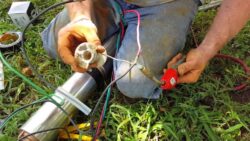In this article, you will discover practical and straightforward techniques to adjust faucet water pressure. Whether you are experiencing water pressure that is too low or too high, these simple methods will help you achieve the ideal water flow for your needs. By following a few easy steps, you can ensure comfortable and consistent water pressure in your faucets, providing you with a seamless and enjoyable user experience. Say goodbye to weak or forceful water streams and take control of your faucet water pressure with these effective techniques.
Common causes of low water pressure
Clogged aerator
One of the common causes of low water pressure is a clogged aerator. An aerator is a device located at the end of your faucet that adds air to the water flow, which helps in conserving water. Over time, mineral deposits and debris can build up in the aerator, causing water flow restriction and resulting in low water pressure.
Faulty pressure regulator
Another cause of low water pressure could be a faulty pressure regulator. Pressure regulators are typically installed near the main water supply line to regulate the water pressure coming into your home. If the pressure regulator malfunctions, it can lead to low water pressure issues throughout your plumbing system.
Leaky pipes and fittings
Leaky pipes and fittings can also be responsible for low water pressure in your faucets. Small leaks in the pipes or fittings can cause a decrease in water flow, resulting in low water pressure. It is important to regularly inspect your plumbing system for any leaks and promptly repair them to maintain proper water pressure.
Closed shutoff valves
Sometimes, low water pressure can be simply due to closed shutoff valves. Shutoff valves are usually located near the water meter or where the main water supply enters your home. If these valves are closed or partially closed, it can significantly reduce the water flow and result in low water pressure in your faucets.
Water main issues
Issues with the water main can also cause low water pressure problems. If there are any disruptions or maintenance activities happening on the water main, it can impact the water pressure in your home. In such cases, it is best to contact your water provider for more information and updates on when the issue will be resolved.
Common causes of high water pressure
Faulty pressure regulator
Similar to low water pressure, a faulty pressure regulator can also be a cause of high water pressure. If the pressure regulator fails to regulate the water pressure effectively, it can result in excessively high water pressure throughout your plumbing system.
Closed pressure-reducing valve
A closed or malfunctioning pressure-reducing valve can also lead to high water pressure issues. The pressure-reducing valve is responsible for reducing the water pressure to a safe and manageable level. If the valve is closed or not functioning properly, it can cause an increase in water pressure.
Blocked water supply line
A blocked water supply line can restrict the water flow and cause high water pressure in your faucets. This can happen due to mineral deposits, debris, or any other obstruction in the water supply line. Regular maintenance and cleaning of the supply lines can help prevent this issue.
Water pressure spikes
Water pressure spikes can occur when there are sudden changes in the water pressure coming into your home. These spikes can cause high water pressure, which can be damaging to your plumbing system and appliances. If you notice frequent water pressure spikes, it is important to address the issue promptly to avoid any potential damage.
Closed shutoff valves
Similar to low water pressure, closed or partially closed shutoff valves can also contribute to high water pressure. It is important to ensure that all the shutoff valves in your plumbing system are fully open to maintain balanced water pressure throughout your home.
Simple techniques to adjust low water pressure
Clean the aerator
To address low water pressure caused by a clogged aerator, you can try cleaning it. Start by unscrewing the aerator from the end of the faucet. Soak it in vinegar for a few hours to break down any mineral deposits. Scrub off any remaining debris, rinse the aerator, and then reinstall it. This should help improve water flow and increase the water pressure.
Check for plumbing leaks
Inspect your plumbing system for any visible leaks. Look for signs of water damage, dampness, or water stains near pipes and fittings. Additionally, you can perform a pressure test to check for hidden leaks. If you find any leaks, repair or replace the damaged pipes to restore proper water pressure.
Adjust the pressure regulator
If you suspect that the pressure regulator is causing low water pressure, you can try adjusting it. Locate the pressure regulator, which is usually near the main water supply line. Refer to the manufacturer’s instructions for the specific adjustment mechanism. You can increase or decrease the pressure based on your needs. After adjusting, test the water pressure to ensure it has improved.
Open shutoff valves completely
Ensure that all the shutoff valves in your plumbing system are fully open. Sometimes, valves can be partially closed, causing a decrease in water flow and resulting in low water pressure. By fully opening the shutoff valves, you can restore proper water flow and increase the water pressure.
Contact the water provider
If none of the above techniques resolve the low water pressure issue, it is advisable to contact your water provider. They can provide guidance and assistance in troubleshooting and resolving any potential water main issues or other factors affecting the water pressure in your area.
Simple techniques to adjust high water pressure
Install a pressure regulator
To address high water pressure, you may consider installing a pressure regulator if your plumbing system does not already have one. A pressure regulator helps regulate the water pressure coming into your home, ensuring it stays within a safe range. Consult a professional plumber to install the appropriate pressure regulator for your needs.
Adjust the pressure-reducing valve
If your home already has a pressure-reducing valve, you can adjust it to lower the water pressure. Locate the valve, which is typically near the main water supply line or the water meter. Refer to the manufacturer’s instructions for the specific adjustment mechanism. Gradually decrease the pressure until it reaches a suitable level.
Clear clogged water supply lines
If you suspect that a clogged water supply line is causing high water pressure, it is important to clear the obstruction. Start by shutting off the main water supply to your home. Disconnect the affected water supply line and use a plumbing snake or auger to remove any blockages. Once cleared, reconnect the supply line and turn on the water to check if the pressure has reduced.
Use a pressure-reducing valve
If you do not have a pressure-reducing valve installed, consider using a pressure-reducing valve on your specific faucets or fixtures. These valves can be attached directly to the faucet or fixture and help regulate the water pressure within a safe range. This can be a temporary solution until a permanent pressure regulator is installed.
Contact a plumber for assistance
If you are unsure about adjusting the water pressure yourself or if the techniques mentioned above do not resolve the high water pressure issue, it is recommended to seek professional assistance from a plumber. They have the expertise and experience to diagnose and address any underlying issues causing high water pressure. A professional plumber can provide a thorough assessment and offer suitable solutions to ensure your plumbing system operates at the appropriate water pressure.
Using a pressure gauge to measure water pressure
Selecting a suitable pressure gauge
When measuring water pressure, it is important to select a pressure gauge that can accurately measure the range of your water pressure. There are various types of pressure gauges available, so choose one that is suitable for your specific needs and plumbing system.
Preparing the faucet for pressure measurement
Before attaching the pressure gauge, ensure that the faucet is in the fully open position. This allows for an accurate measurement of the water pressure in your plumbing system. Remove any aerators or flow restrictors from the faucet to get an unrestricted reading.
Attaching the pressure gauge
Attach the pressure gauge to the open faucet securely. Make sure there are no leaks or loose connections that can affect the accuracy of the measurement. Follow the manufacturer’s instructions for proper attachment and ensure the gauge is properly calibrated.
Reading and interpreting the pressure
Once the pressure gauge is attached, turn on the water to allow it to flow through the gauge. The gauge will display the current water pressure in your plumbing system. Take note of the reading and compare it to the recommended water pressure range for your area. If the reading falls outside the acceptable range, adjustments may be necessary.
Cleaning and replacing the aerator
Removing the aerator
To clean or replace a clogged or faulty aerator, start by turning off the faucet and unscrewing the aerator from the end of the faucet. Carefully twist it counterclockwise until it comes off.
Soaking the aerator in vinegar
To remove mineral deposits and debris, soak the aerator in vinegar. Fill a bowl or container with vinegar and submerge the aerator. Allow it to soak for a few hours or overnight to dissolve the buildup.
Scrubbing off debris
After soaking, use a toothbrush or small brush to scrub off any remaining debris from the aerator. Pay attention to the mesh screen and the flow restrictor if present. Thoroughly clean all parts to ensure proper water flow.
Reinstalling the clean aerator
Once the aerator is clean and free from debris, reattach it to the faucet by twisting it clockwise. Make sure it is securely tightened, but be careful not to overtighten and potentially damage the threads. Turn on the faucet to check if the water pressure has improved.
Replacing a faulty aerator
If cleaning the aerator does not resolve the low water pressure issue, it may be necessary to replace it. Purchase a suitable replacement aerator from a hardware store or plumbing supply store. Follow the same steps as above to remove the old aerator and install the new one. Ensure a proper fit and test the water pressure afterward.
Adjusting the pressure regulator
Locating the pressure regulator
The pressure regulator is typically located near the main water supply line or the water meter. It may be installed indoors or outdoors, depending on the specific setup of your plumbing system. Consult the plumbing schematic or seek professional guidance to locate the pressure regulator.
Understanding the adjustment mechanism
Pressure regulators have different adjustment mechanisms, such as adjusting screws, knobs, or dials. Refer to the manufacturer’s instructions or consult a professional plumber to understand the specific adjustment mechanism of your pressure regulator.
Increasing or decreasing pressure
To adjust the pressure regulator, turn the adjustment screw, knob, or dial in the appropriate direction. Clockwise rotation generally increases the water pressure, while counterclockwise rotation decreases it. Make small adjustments and test the water pressure after each adjustment to achieve the desired result.
Testing the water pressure after adjustment
After making adjustments to the pressure regulator, test the water pressure in your plumbing system using a pressure gauge. Attach the gauge to a faucet and turn on the water to check if the pressure falls within the acceptable range. If necessary, continue making small adjustments until the desired water pressure is achieved.
Checking for plumbing leaks
Examining visible pipes and fittings
Start by visually inspecting all visible pipes and fittings in your plumbing system. Look for any signs of leaks, such as water stains, dampness, or mold growth. Feel for moisture around pipes and fittings to identify any potential leaks.
Performing a pressure test
To identify hidden leaks, you can perform a pressure test. Shut off all faucets and water-consuming appliances in your home. Attach a pressure gauge to a faucet and turn on the water. Observe the pressure gauge reading. If the pressure drops significantly over a few minutes, it could indicate a hidden leak in your plumbing system.
Locating hidden leaks
If the pressure test indicates a hidden leak, you will need to locate its source. Start by checking for any water damage or dampness on walls, ceilings, or floors near the plumbing pipes. Listen for the sound of running water when no faucets are in use. Inspect crawlspaces, basements, and areas where plumbing pipes are exposed to identify any visible signs of leaks.
Repairing or replacing damaged pipes
Once you have identified the location of the leak, you can begin repairing or replacing the damaged pipes. This may involve tightening loose fittings, replacing faulty washers or gaskets, or soldering new sections of pipe, depending on the extent of the damage. If you are unsure about the repair process, it is advisable to seek assistance from a professional plumber.
Using a pressure-reducing valve
Installing a pressure-reducing valve
To use a pressure-reducing valve, start by turning off the main water supply to your home. Locate the appropriate position in your plumbing system to install the valve. This is usually near the main water supply line or the water meter. Follow the manufacturer’s instructions to install the valve, making sure all connections are secure.
Adjusting the valve to a desired pressure
Once the pressure-reducing valve is installed, you can adjust it to your desired water pressure. Typically, pressure-reducing valves feature an adjustment screw or dial. Turning it clockwise usually increases the water pressure, while turning it counterclockwise decreases it. Adjust the valve gradually and test the water pressure to achieve the desired result.
Monitoring and maintaining the valve
Regularly monitor the water pressure in your plumbing system to ensure it stays within the desired range. If you notice any fluctuations or changes in water pressure, check the pressure-reducing valve for any adjustments or maintenance requirements. It is important to maintain the valve to ensure it continues to regulate the water pressure effectively.
Calling a professional plumber for assistance
When to seek professional help
If you are unable to resolve water pressure issues on your own or if you are uncomfortable making adjustments to your plumbing system, it is best to seek professional help. Plumbers have the expertise, experience, and appropriate tools to diagnose and address complex water pressure problems.
Finding a reliable plumber
When searching for a reliable plumber, consider asking for recommendations from friends, family, or neighbors. You can also check online reviews and ratings for reputable plumbing professionals in your area. Look for plumbers who are licensed, insured, and experienced in dealing with water pressure issues.
Communicating the issue
When contacting a plumber for assistance, clearly communicate the water pressure issue you are experiencing. Provide any relevant details, such as when the issue started, whether it affects only certain faucets or fixtures, and any previous attempts you made to resolve the problem. This information will help the plumber better understand the situation and provide appropriate solutions.
Obtaining cost estimates
Before hiring a plumber, obtain cost estimates for the necessary repairs or adjustments. The plumber should provide a detailed breakdown of the costs, including labor, materials, and any potential additional charges. Review the estimates and compare them with other plumbers to ensure you are getting a fair and competitive price.





